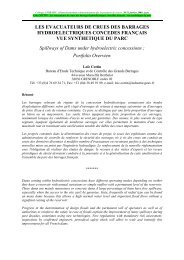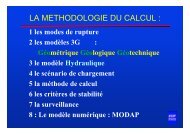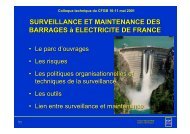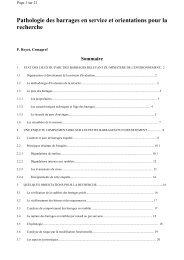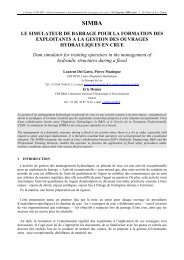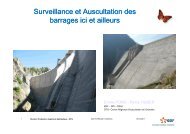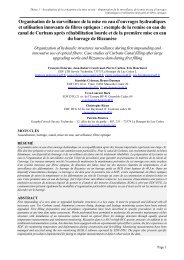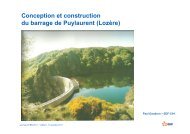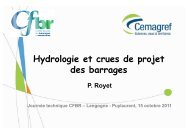SMALL DAMS
SMALL DAMS - Comité Français des Barrages et Réservoirs
SMALL DAMS - Comité Français des Barrages et Réservoirs
- No tags were found...
You also want an ePaper? Increase the reach of your titles
YUMPU automatically turns print PDFs into web optimized ePapers that Google loves.
Chapter IV<br />
CONSTRUCTION PRINCIPLES TO BE STIPULATED IN THE PARTICULAR TECHNICAL<br />
CLAUSES<br />
Protection of the construction site from water<br />
This addresses the following problems:<br />
!" collecting springs and infiltration, and release outside the various excavations;<br />
temporary or permanent structures may be required;<br />
!" protection of the fill and the borrow areas from runoff;<br />
!"the particular technical clauses should stipulate up to what flow the construction site<br />
should be protected, for example the 10-year flood calculated over the period of<br />
construction, but for practical reasons, this flow will be translated into an elevation in<br />
the tender documents and contract. That elevation will be referenced to a fixed point<br />
downstream from the construction site. The contractor bears the sole liability for protection<br />
of the construction site and his equipment as long as that elevation is not<br />
exceeded.<br />
Conditions for quarrying in borrow areas<br />
The preliminary studies will have defined the various types of materials encountered<br />
in the borrow areas and, according to their intrinsic and in situ characteristics, will<br />
have assigned them a function and a place in the structure, or for some of them, will<br />
have decided to eliminate them.<br />
Additional site investigations and tests must be done to detail the results of the study<br />
as soon as the test section is begun.<br />
After stripping to eliminate and store topsoil and plant debris, a plan for operation of<br />
the borrow area defining what part of the structure the various materials are destined<br />
for should be set up.<br />
Materials are extracted either in horizontal layers, which would permit some drying<br />
by the sun and the wind, or in vertical layers, which would permit mixing of the<br />
various layers.<br />
The extracted materials can only be placed directly if their water content is within the<br />
prescribed range. If not, drainage of the borrow areas or temporary storage for<br />
drying or wetting can be necessary, and a cost for this work should be given in the<br />
price schedule.<br />
101<br />
Preparation of excavations<br />
After examination of the base of the embankment and the cut-off, it may prove<br />
necessary to excavate deeper.<br />
Before placing any fill or concrete:<br />
!" the surface of the excavation bottom must be cleaned and strengthened;<br />
!" a detailed survey must be done;<br />
!" the excavations must be formally accepted (see Chapter III, p. 62).



